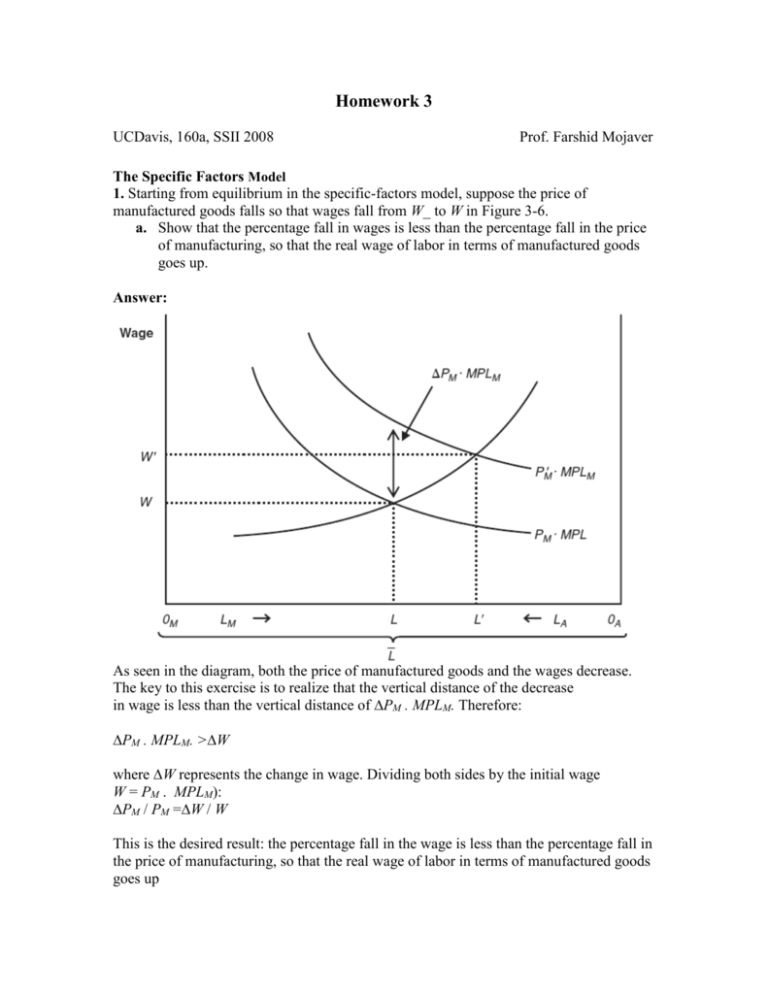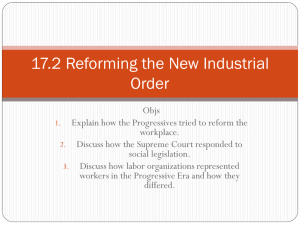Homework 3 - Economics
advertisement

Homework 3 UCDavis, 160a, SSII 2008 Prof. Farshid Mojaver The Specific Factors Model 1. Starting from equilibrium in the specific-factors model, suppose the price of manufactured goods falls so that wages fall from W_ to W in Figure 3-6. a. Show that the percentage fall in wages is less than the percentage fall in the price of manufacturing, so that the real wage of labor in terms of manufactured goods goes up. Answer: As seen in the diagram, both the price of manufactured goods and the wages decrease. The key to this exercise is to realize that the vertical distance of the decrease in wage is less than the vertical distance of ∆PM . MPLM. Therefore: ∆PM . MPLM. >∆W where ∆W represents the change in wage. Dividing both sides by the initial wage W = PM . MPLM): ∆PM / PM =∆W / W This is the desired result: the percentage fall in the wage is less than the percentage fall in the price of manufacturing, so that the real wage of labor in terms of manufactured goods goes up b. What happens to the real wage of labor in terms of agriculture? Answer: Because the wage decreases and the price of agricultural goods remains the same, the amount of agricultural goods that can be bought by labor decreases. That is, real wage decreases in terms of agriculture. Because the wage decreases and the price of agricultural goods remains the same, the amount of agricultural goods that can be bought by labor decreases. That is, real wage decreases in terms of agriculture. c. Are workers better off, worse off, or is the outcome ambiguous? Answer: Because the real wage increases with respect to manufactured goods and decreases with respect to agriculture, the outcome will be ambiguous for workers. For some, who prefer to purchase a lot of agriculture, the price change means an overall loss in terms of how much they can buy. Others, who prefer to buy mainly manufactured goods, gain in terms of how much they can buy. 2. Use the following information to answer the questions below: Manufacturing: Agriculture: Sales revenue = PM . QM = 150 Payments to labor = W LM = 100 Payments to capital = RK K=50 Sales revenue = PA . QA = 150 Payments to labor = W LM = 50 Payments to land = RT T=100 Holding the price of computers constant, suppose the increase in the price of agriculture is 10% and the increase in the wage is 5%. a. Determine the impact of the increase in the price of agriculture on the rental on land and the rental on capital. b. Explain what has happened to the real rental on land and the real rental on capital. Answer: Because of the 10% increase in the price of agriculture, the real rental on land rose whereas the real rental on capital fell. Therefore, landowners are better off because the percentage increase in the rental on land is greater than the percentage increase in the price of agriculture, whereas the price of manufacture is constant. Capital owners are worse off in terms of their ability to purchase both manufacture and agriculture because the rental to capital has fallen. 3. Read the article by Lori G. Kletzer and Robert E. Litan,“ A Prescription to Relieve Worker Anxiety,” Policy Brief 01-2, Institute for International Economics, Washington, DC, www.iie.com/publications/pb/pb01-2.htm. Then answer the following questions. a. Under the most recent version of Trade Adjustment Assistance (TAA) in the United States, how many extra weeks of unemployment insurance (UI) are workers eligible for? What two criteria must they meet to qualify for this extra unemployment insurance? Answer: “Under the most recent version of the Trade Adjustment Assistance (TAA) Act, qualified workers may gain an additional 52 weeks of UI payments, provided they are enrolled in an approved training program. A similar program, the North American Free Trade Agreement Transitional Adjustment Assistance (NAFTA-TAA) program, was created in 1993. For eligibility, workers must prove that they lost their job because of increased imports from, or a shift in production to, either Canada or Mexico.” b. Consider the proposal for “wage insurance” that Kletzer and Litan make in their article. What criteria would a worker need to meet to qualify for this insurance? What amount of extra income would they receive from the insurance? Answer: “Wage insurance would work as follows: Eligible workers would receive some fraction of their wage loss, which could vary by age and tenure of the worker for up to 2 years following the initial date of job loss, but would begin to be paid only when workers found a new job.” “To qualify for our proposed supplemental wage insurance benefit, workers need only document that they have been ‘displaced’ according to criteria similar to the operational definition of displacement used by the BLS in its Displaced Worker Surveys (plant or company closed or moved, elimination of position or shift, insufficient work); that they had served at their previous job for a minimum period of time: we suggest 2 years; and that they have suffered an earnings loss (from old job to new job) . . .” c. If Kletzer and Litan’s new plan for “wage insurance” had been adopted by the United States, what would have been the budgetary cost in 1999 when unemployment was 4.2%? How does this compare with the amount that is now spent on unemployment insurance? Answer: “Assuming a 50% replacement and subsidy rate, the table indicates that our wage insurance and health insurance program would have cost about $2.9 billion in 1999, when the national unemployment rate averaged 4.2%. “The total cost, less than $4 billion, might have been a major obstacle when federal deficits were high and growing but is not a problem now, and in any event would be small in relation to the more than $20 billion that is now spent on unemployment insurance . . .” 4. In the specific factors model, again suppose that the relative price of manufactured goods decreases. That is, assume that the price of agricultural goods increases while the price of manufactured goods is unchanged (i.e. ΔPA/PA > 0 and ΔPM/PM = 0). Arrange the following terms in ascending order: ΔRT/RT ΔRK/RK ΔPA/PA ΔPM/PM ΔW/W Hint: Try starting with a diagram such as Figure 3-6 but change the price of agricultural goods instead. Answer: ΔRT/RT > ΔPA/PA > ΔW/W > 0 = ΔPM/PM > ΔRK/RK 5. Suppose two countries, Canada and Mexico, produce two goods, timber and televisions. Assume that land is specific to timber, capital is specific to televisions, and labor is free to move between the two industries. When Canada and Mexico engage in free trade, the relative price of televisions falls in Canada and the relative price of timber falls in Mexico. a. In a graph similar to Figure 3-6, show how the wage changes in Canada because of a fall in the price of televisions, holding constant the price of timber. Can we predict that change in the real wage? Answer: As shown by the following figure, real wage falls but by less than the percentage decrease in the price of televisions. b. What is the impact of opening trade on the rentals on capital and land in Canada? Can we predict that change in the real rentals on capital and land? Answer: Because capital is specific to the television sector, the drop in the relative price of television will lead to a fall in the rental on capital. With Canada exporting timber, rental on land will rise because land is specific to the timber industry. c. What is the impact of opening trade on the rentals on capital and land in Mexico? Can we predict that change in the real rentals on capital and land? Answer: Through the exports of televisions, the relative price of televisions will rise in Mexico, which will lead to an increase in the rental on capital. By contrast, the rental on land will fall. d. In each country, has the specific factor in the export industry gained or lost, and has the specific factor in the import industry gained or lost? Answer: In both cases, the specific factor in the export industry (i.e., land in Canada and capital in Mexico) gained whereas the factor specified to the import industry (i.e., capital in Canada and land in Mexico) loses when the two countries engage in trade. 6. Home produces two goods, computers and wheat, where capital is specific to computers, land is specific to wheat, and labor is mobile between the two industries. Home has 100 workers and 100 units of capital, but only 10 units of land. a. Draw a graph similar to Figure 3-1, with the output of wheat on the vertical axis and the labor in wheat on the horizontal axis. What is the relationship between the output of wheat and the marginal product of labor in the wheat industry as more labor is used? Answer: See the following graph. As more labor is added to the production of wheat, the marginal product of labor declines so that although the output of wheat continues to increase, the output is increasing at a decreasing rate. b. Draw the production possibilities frontier (PPF) for Home with wheat on the horizontal axis and computers on the vertical axis. Answer: See the following graph. b. Draw the production possibilities frontier (PPF) for Home with wheat on the horizontal axis and computers on the vertical axis. Answer: See the following graph. c. Explain how the price of wheat relative to computers is determined in the absence of trade. Answer: In the absence of international trade, the relative price of wheat is the slope of the line tangent to the PFF and Home’s indifference curve. d. Reproduce Figure 3-5 with the amount of labor used in wheat measuring from left to right along the horizontal axis, and the amount of labor used in computers moving in the reverse direction. Answer: See graph below. e. Assume that because of international trade, the price of wheat rises. Analyze the effect of the increase in the price of wheat on the allocation of labor between the two sectors. The increase in the price of wheat shifts the PW MPLW curve upward to PW'MPLW so that the new equilibrium is at point B. The amount of labor used in wheat increases from 0WL to 0WL', although the amount of labor devoted to computer decreases from 0CL to 0CL'. Although the wage rises from W to W', the increase is less than the vertical shift of the PW MPLW curve given as ∆PW MPLW. Heckshcer-Ohlin Model Jeopardy Answers DIRECTIONS: As in the popular TV game show, you are given an answer to a question and you must respond with the question. For example, if the answer is, "a tax on imports", then the correct question is, "What is a tariff?" 1. term used to describe Argentina if Argentina has more land per unit of capital than Brazil. 2. term used to describe aluminum production when aluminum production requires more energy per unit of capital than steel production. 3. general term used to describe the amount of a factor needed to produce one unit of a good. 4. the two key terms used in the Heckscher-Ohlin model; one to compare industries, the other to compare countries. 5. term used to describe when the capital-labor ratio in an industry varies with changes in market wages and rents 6. term describing the ratio of the unit-capital requirement and the unit-labor requirement in production of a good. 7. the assumption in the Heckscher-Ohlin model about unemployment of capital and labor. 8. interpretation given for the slope of the production possibility frontier. 9. the H-O model theorem that would be applied to identify the effects of a tariff on the prices of goods and factors. Jeopardy Answers 10. term used to describe Argentina if Argentina has more land per unit of capital than Brazil. Land abundant country 11. term used to describe aluminum production when aluminum production requires more energy per unit of capital than steel production. Aluminum is an energy intensive industry 12. general term used to describe the amount of a factor needed to produce one unit of a good. Unit Factor Requirement 13. the two key terms used in the Heckscher-Ohlin model; one to compare industries, the other to compare countries. Labor (capital) intensive industry; labor (capital) abundant country 14. term used to describe when the capital-labor ratio in an industry varies with changes in market wages and rents Variable factor proportions 15. term describing the ratio of the unit-capital requirement and the unit-labor requirement in production of a good. Capital intensity 16. the assumption in the Heckscher-Ohlin model about unemployment of capital and labor. Zero 17. interpretation given for the slope of the production possibility frontier. Opportunity cost of production (Y in terms of X) 18. the H-O model theorem that would be applied to identify the effects of a tariff on the prices of goods and factors. Stolper-Samuelson Theorem Multiple Choice Questions 1. In the 2-factor, 2 good Heckscher-Ohlin model, the two countries differ in: A. tastes. D. relative availabilities of factors of production. B. military capabilities. E. labor productivities. C. size. 2. In the 2-factor, 2 good Heckscher-Ohlin model, a change from autarky (no trade) to trade will benefit the owners of: A. capital. B. the relatively abundant factor of production. C. the relatively scarce factor of production. D. the relatively inelastic factor of production E. the factor of production with the largest elasticity of substitution. 3. One way in which the Heckscher-Ohlin model differs from the Ricardo model of comparative advantage is by assuming that __________ is (are) identical in all countries. A. factor of production endowments D. technology B. scale economies E. opportunity costs C. factor of production intensities 4. According to the Hecksher-Ohlin model, A. everyone automatically gains from trade B. the scarce factor necessarily gains from trade C. the gainers could compensate the losers and still retain gains. D. a country gains if its exports have a high value added. E. None of the above. 5. Starting from an autarky (no-trade) situation with Heckscher-Ohlin model, if Country H is relatively labor abundant, then once trade begins: A. wages and rents should rise in H. B. wages and rents should fall in H. C. wages should rise and rents should fall in H. D. wages should fall and rents should rise in H. E. None of the above. 6. Suppose that there are two factors, capital and land, and that the United States is relatively land endowed while the European Union is relatively capital-endowed. According to the HeckscherOhlin model, A. European landowners should support US-European free trade. B. European capitalists should support US-European free trade. C. all capitalists in both countries should support free trade. D. all landowners should support free trade. E. None of the above. 7. Assume that only two countries, A and B, exist. Consider the following data: Countries Factor Endowments A B Labor Force 45 20 Capital Stock 15 10 If good S is capital intensive, then following the Heckscher-Ohlin Theory, A. country A will export good S. B. country B will export good S. C. both countries will export good S. D. trade will not occur between these two countries. E. Insufficient information is given. MC Question: 1.D, 2.B, 3.D, 4.C, 5.C, 6.B, 7.B False, True, Or Uncertain, Explain Why (Questions in Heckscher-Ohlin Theory) Question 1 “Opening up free trade does hurt people in import-competing industries in the short run. But in the long run, when people and resources can move between industries, everybody ends up gaining from free trade.” Question 2 “American workers gain from free trade with China because free trade lowers prices of clothing in the United States and American workers spent very large portion of their income on clothing” True False questions Question1 “Opening up free trade does hurt people in import-competing industries in the short run. But in the long run, when people and resources can move between industries, everybody ends up gaining from free trade.” False – Opening up free trade is likely to hurt some people. Owner of specialized factors in import-competing industries and owners of factors used intensively in importcompeting industries will lose from free trade both in the short and in the long run. Question2 “American workers gain from free trade with China because free trade lowers prices of clothing in the United States and American workers spent very large portion of their income on clothing” False – Free trade lowers clothing prices in the United States but it lowers real wage of American worker too. Since wage income is the main source of American workers we may conclude that their income goes down with opening up trade with China. 1. This exercise uses the Heckscher-Ohlin model to predict the direction of trade. Consider the production of hand-made rugs and assembly line robots in Canada and India. a. Which country would you expect to be relatively labor-abundant, and which capitalabundant? Why? Answer Given Canada’s relatively small population (30 million compared with more than 1 billion in India) and level of development, it is a safe assumption that LCAN / KCAN < LIND / KIND. That is, there is more capital per worker in Canada, making it capital-abundant compared with India. Similarly, India would be labor abundant. b. Which industry would you expect to be relatively labor-intensive, and which is capitalintensive? Why? Answer: Given the amount of capital required to produce robots and the amount of labor required to produce rugs, one would expect that LROBOT / KROBOT < LRUG / KRUG, making robots capital intensive and rugs labor intensive. c. Given your answers to (a) and (b), draw production possibilities frontiers for each country. Assuming that consumer preferences are the same in both countries, add indifference curves and relative price lines (without trade) to your PPF graphs. What do the slopes of the price lines tell you about the direction of trade? Canada’s no-trade production and consumption of robots and rugs corresponds to a relative price of robots that is lower than that in India. This is shown by the flatter sloped relative price line in Canada. d. Allowing for trade between countries, redraw the graphs and include a “trade triangle” for each country. Identify and label the vertical and horizontal sides of the triangles as either imports or exports. 2. Leontief ’s Paradox is an example of testing a trade model using actual data observations. If Leontief had observed that the amount of labor needed per $1 million of U.S. exports was 100 instead of 182,would he have reached the same conclusion? Explain. Answer: If the amount of labor required for $1 million of U.S. exports was 100 personyears instead of 182, then the capital/labor ratio for exports would have been $25,500 per person. Because this is larger than the corresponding ratio for imports, this test would have provided support for the Heckscher-Ohlin theorem. That is, the United States (which was assumed to be capital-abundant in both cases) would have been shown to export capital-intensive goods. In actuality, however, Leontief ’s test showed exactly the opposite. 3 According to the Heckscher-Ohlin model, two countries can equalize wage differences by either engaging in international trade in goods or allowing skilled and unskilled labor to freely move between the two countries. Comment. Answer: Allowing skilled workers to migrate to skilled-labor scarce countries and unskilled workers to migrate to unskilled-labor scarce countries reduces the ratio of skilled/unskilled workers in the skilled-labor-abundant country and raises it in unskilledlabor-abundant country. This increases the wage ratio between skilled and unskilled labor in the skilled-labor-abundant country and lowers it in the unskilled-labor-abundant country. When the two countries trade in goods that embody these factors, the skilledlabor abundant country will export the skilled-labor-intensive good. By doing so, it effectively sends a lot of skilled workers and a few unskilled workers to the unskilled labor- abundant country. Likewise, when it imports the unskilled-labor-intensive good, it effectively imports a few skilled workers and a lot of unskilled workers. The net effect is skilled workers in the unskilled-labor-abundant country see a fall in their wage relative to unskilled labor and unskilled workers experience a rise in their relative wage, similar to that of migration. 4. According to the standard Heckscher-Ohlin model with two factors (capital and labor) and two goods, movement of Turkish migrants to Germany would decrease the amount of capital-intensive products produced in Germany. Discuss whether this is true or false, and explain why. Answer: An increase in a factor of production raises the production of the good that uses that factor intensively and reduces the production of the other good. 5. Consider the following information on the factor endowments of two countries: Factor Endowments Labor Force Capital Stock United States 30 million workers 200,000 machines Austria 15 million workers 400,000 machines a. The capital to labor ratios are U.S.: 200,000/30,000,000 = 2/300 Austria: 400,000/15,000,000 = 4/150 = 8/300 Since 8/300 > 2/300, Austria is relatively capital abundant. b. The labor to capital ratios are U.S.: 30,000,000/200,000 = 150 Austria: 15,000,000/400,000 = 150/4 Since 150 > 150/4, U.S. is relatively labor abundant. c. Austria has the comparative advantage in the production of steel, according to the Heckscher-Ohlin Theorem, “Because steel uses Austria’s relatively abundant factor (capital) more intensely in its production than do textiles. Therefore, Austria should produce and export steel (although it may still produce some textiles as well, according to H-O theory). 6. Imagine a two good H-O economy which imports automobiles and exports wheat. Suppose the production of these two goods use only capital and labor. If the government raises a tariff on the import of automobiles it will raise the domestic price of autos. Suppose the price of wheat remains constant. Explain as a result of this tariff who in the economy will gain and who will lose in real terms? With an increase in price of Auto relative demand shifts in favor of Auto production and hence relative demand for Capital goes up (relative demand for labor goes down). This will lead to a decrease in L-K ratio employed in the two sectors which lowers real Wage rates and increases real rentals. Tariff on Auto imports PA↑ >0 and so does the cost of production. Since Auto is capital intensive domestic QA ↑ demand for K↑ R↑ and R/PA↑ & R/PW↑ Similarly can show PA↑=> L/K↓ =>MPL↓ W↓ and W/PA↓ & W/PW↓ Rent earners win and Wage earners lose Problem 6 Using a HO framework discuss the effects of U.S.-China trade on Skilled-Unskilled wage gap in US and China. Do we actually see these predicted effects on skilled-unskilled wage gaps in the two countries? Are you satisfied with this HO explanation of rising skilled-unskilled wage gap in US? HO would predict that as result of trade between skilled scarce China and skilled abundant US, price of skilled intensive products increase in US (decrease in China) according to SS this should lead to an increase in wages of skilled labor (a reduction of wages of unskilled labor). We expect the opposite to happen in China. That is as result of US-China trade we expect skilled-unskilled wage gaps to increase in US and to decrease in China. We observe the increase in skilled-unskilled wage gaps in US but we do not see the wage gap reductions we expected to see in China. If anything this has actually increase in China. HO explanation is not quite satisfactory because, first we are see conflicting effects, second US trade with NIC’s constitutes only a small fraction of total U.S spending; this is too small to explain the increased gap.








